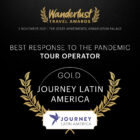Art in Bogota by Richard Holledge

Who would go to Bogotá? Everyone knows Colombia and its capital is much too dangerous. Riven by conflict between leftist guerrillas and right wing para - military groups and devastated by the tyranny of the drug cartels. It was, declared Colombia’s finest writer, Gabriel García Márquez, a country consumed by a “biblical holocaust.”
Even as recently as six or seven years ago Journey Latin America itself would only recommend a trip to the country with a cautionary ‘Travel with Care’ label.
But that was then. Now Bogotá has gone from fear to hope.
A remorseless crackdown on the gangs by President Álavro Uribe, who held office from 2002 to 2010, resulted in the murder rate falling from 80 murders per 100,000 residents in 1993 to 17 by 2013. The number of millionaires in Colombia had grown by 39 per cent since 2007 and evidence of that wealth can be seen in the smart new blocks of flats, fashionable restaurants - try the Tabula in the Macarena district - and shopping malls - though there are policemen and security guards on every corner.
Another symbol of the new Colombia is the outpouring of art, the growth in the number of galleries and art fairs. This October (24 to 27) sees the opening of the tenth ArtBo - the Colombian capital’s annual art fair - with contributions by 66 galleries from 36 countries showing contemporary works as well as works from the 1940s to 1980s and a display of emerging artists.
“We are the focus for art in Bogotá and the country as a whole,” says Maria Paz Gaviria, Director of ArtBo and daughter of former president César Gaviria. “We held our first fair in 2005 with 29 galleries from seven countries but though it has grown a great deal since then and attracted great deal of interest we want to keep it a boutique fair, to keep it manageable.”
ArtBo is the pinnacle of an art boom which has seen the number of private galleries growing from a tiny handful to about forty with other international fairs and artists winning worldwide recognition. If confirmation of the resurgence was needed it came from the British publisher Phaidon Press last October when it included Bogotá on a list of ten ‘Art Cities of the Future.’
As Jose Roca, whose own gallery, Flora, opened last year, writes in the book: “With no outside intervention, the local scene emerged without the pressures of the market (no production frenzy artificially induced by biennials or galleries). So when outsiders finally visited they were pleasantly surprised to find a very mature scene with artists that would be major players on the international circuit had they been working in a more connected or more visible environment.”
Gallery owner Catalina Casas is one of a new breed able to take advantage of her home city’s relative harmony. She owned a gallery in Miami, USA, but in 2005 opened Casas Riegner in a fashionable quarter of Bogotá and begin to promote the works of the 20 artists on her books to a wider audience. Many are familiar in Colombia and some are gaining a global reputation. One of her stable, Mateo Lopez is launching the fair with his installation, Disorientated House, a plywood dwelling which he will float along a lake in the city’s Botanical Gardens.
She says: “The whole security issue, fortunately and thank God, has never been something in my life it always makes the headlines and I’m frustrated when I want to talk about art and people want to talk about the politics.”
Bogotá artist Miguel Angel Rojas insists that as well as the coincidence of money and peace the interest in Colombian contemporary art is dependent, above all, on its high standard.
Best known, for his undercover filming of the forbidden gay scene in the city’s Faenza theatre during the 1970s, Mr Angel says: “Paradoxically this high level of quality is directly related to the intense violence the country lived through for years. The first internationally recognised contemporary Colombian artists were those that responded to this adversity.”
He defines the current art scene in Colombia as ‘post Fernando Botero,' the hugely popular artist whose bronzes and paintings of voluminous caricatures are worth millions of dollars and seen in many public spaces and museums.
“For years local collectors were only interested in Botero's work,” says Mr Angel. “They did not support more experimental art from Colombia. This is no longer the case.”
He points out that a great deal of progress has been made in terms of the infrastructure and organisation of arts from the biennials held in the cities of Cali and coastal city of Cartagena where the first biennial was held earlier this year. More striking perhaps, in Medellin, a city cursed for years by the malign rule of the drug cartels, a $12 million extension to the Museum of Modern Art will open next year as part of the city’s regeneration plans.
The Museo de Arte del Banco de la Republica was opened in 2004 and is an essential component in the Bogotá’s art scene with its collection of around 5000 works of Colombian art from the 17th century to the present day. The fabulous Gold Museum has unparalleled displays of artefacts from the land that gave us Eldorado.
As Mariá Paz Gaviria says; “We are creating a mini Miami here but it’s Bogotá and it’s better.”
For longer versions of this article see: FT and Gulf News (due to feature Fri.17.Oct.14)
Richard Holledge writes about the arts for the Wall Street Journal and the Gulf News.
Tailor-made holidays
Flexible, custom-made holidays to Latin America created to match your exact requirements: our tailor-made itineraries are as unique as the clients for whom they are designed.
Design my trip


























